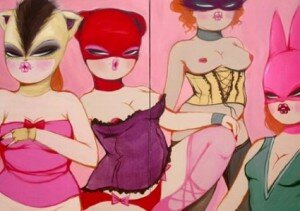 originally posted November 11, 2010
originally posted November 11, 2010
For three years I’ve spent an autumn weekend in Tucson, Arizona attending a one day event produced by Baja Leather Arizona. Behind Closed Doors is a unique experience, where all the action but the play party- classes, vending and keynote are all held in a hotel ballroom- the staff sets up cloth partitions and the classes and vending run simultaneously. While this sounds problematic, it winds up being beneficial. Energy flows freely, and you can wonder in and out of class as needed with out being a bother. For the keynote, which happens after the last class session, the come down. It’s an intimate experience, and even with a shorter time-frame than your average convention, I’ve heard several comments that attendees feel more connected to each other. The play party is hosted at newly renovated local club Desert Dominion and is well attended by club members and con attendees alike.
I sat down with Jefferson James, the event producer and owner of Baja Leather Arizona in the hotel’s restaurant after arriving on Friday, and followed up with him afterward.
How did Behind Closed Doors come to be?
“Several years ago, Master Trish proposed that Desert Dominion put on a fetish ball. I sort of bullied my way into being the co-producer. The name Southwest Fetish Ball was chosen and for four years She and I, with a handful of volunteers, worked together to make it happen.
Throughout those four years, She and I had conflicting views on just what the event should be. Hindsight being 20/20, I can now say that she wanted the Southwest Fetish Ball to be a fetish ball. I wanted it to be an educational event.
Shortly after I had decided not to be a part of the event anymore, I learned that Master Trish had decided to pursue other things as well. During a very brief moment of megalomania, I reconsidered leaving the event. It was when I felt I had the power to make the Southwest Fetish Ball whatever I wanted it to be that I realized that what I wanted to produce was not a fetish ball at all.
In the meantime, I’d been going to the Southwest Leather Conference (SWLC) and was doing a lot of evangelizing. I was telling anyone who would listen just how great I thought SWLC was and how they should go. Southern Arizona tends to be a little isolated, though, and many people knew nothing about the presenters. Often the response I got was that the cost of the event coupled with travel expenses and paying for a hotel for the weekend was a lot of money to spend based solely on my recommendation.
Then, during the first half of 2007, I was contacted by the Leather Leadership Conference and asked to put on their very first regional event. It was then that I decided to form Baja Arizona Leather and to use LLC: Tucson as a test flight of sorts for Behind Closed Doors, which I envisioned to be a feeder event for the Southwest Leather Conference.
The subtitle we gave the first Behind Closed Doors was A Sneak Peek. This tied in well with our keyhole logo and with our goal of giving attendees a small, and therefore more affordable, taste of what to expect from a full-blown conference like Southwest Leather.
We also intentionally avoided using the word Leather in the name of our event and in our promotion of it. A lot of the newer people in the local scene are confused by the word and therefore don’t identify with it. Many people told me they thought it was strictly a gay male thing. This is what inspired our first keynote address.”
How do you pick the topics and keynote speakers?
“We had the topic of What it Means to be Leather and began the process of deciding who would be best to convey the message. Because we were trying to dispel the myth that you had to be a kinky gay male to be Leather, we wanted a Leatherwoman. We wanted Lauren Ide.
In my very first conversation with Lauren regarding the keynote, I learned that she and I had totally different views on what it meant to be Leather. At the time, I felt it was an umbrella term that applied to all of us, and not just a subset. She felt the exact opposite.
Due to further conversations with her, my opinion shifted. In discussing my views with her peers and mentors, hers shifted. She had been the conservative and I was the liberal, so to speak. Then, ironically, I was the more conservative one and she was the more liberal. It really opened my eyes, though, to the fact that ours is a living and evolving culture.
For our second year, Peek-a-Two, we wanted a speaker that spoke to that evolution. We wanted someone from the next generation that respected and honored the traditions of the past and who could speak to the issues of our future. Once again, it was a no-brainer. We wanted Julian Wolf.
We have continued, and will continue, to choose our keynote speaker based on who we feel can best articulate our vision of what to many outsiders might appear to be a paradox: The growth of a community whose members celebrate that the main thing they have in common is that they are all different.”
This year Master Z of Dallas was slated to teach and give the keynote address but was unfortunately unable to attend due to sudden illness. Instead of canceling, Jefferson reached out to two members of the greater Arizona community. Whipmaster Bob Clark and his property BootPig stepped up to the plate. Whipmaster Bob taught an extra class and with only hours of warning BootPig gave the keynote address. The topic this year was “Acceptance and Tolerance.”
What was your goal for Behind Closed Doors when you started? Has that changed?
“Part of Baja Arizona Leather’s original mission was to bring BDSM education and camaraderie to southern Arizona. That hasn’t changed. On the other hand, we no longer see Behind Closed Doors strictly as being a feeder event for Southwest Leather. We still highly encourage our attendees to go to SWLC, but we are coming of age and forging our own separate identity. We too continue to evolve. This March we added Baja Bound, a bondage-specific event. We may add other events over time.
Across the country, various events have nicknames. There is the Love Con, the Sex Con, the Woo Con and others. With its three unofficial tracks of Intermediate SM, Advanced SM and Relationships, we see Behind Closed Doors as a bit of a BDSM smorgasbord. This, however, is not etched into stone, but instead cut into living flesh that may look totally different in the future as we all grow and learn together.
Whipmaster Bob and BootPig were gracious enough to share a draft of the address, and below are a few segments.
“There is a right way and a wrong way to how I live my life, my leather. That’s what ethics are about. If I do not agree with a situation from an ethical perspective, I have a duty to speak truth about it. That’s integrity. I have to be willing to put myself in a vulnerable place, to walk my walk, like maybe now. That’s honor. I have to be unwilling to speak or act in a manner that I am not willing to answer for. That’s all of it rolled into one.
I don’t expect one single other person to embrace that particular perspective. It is my purple dress and red hat and it is as valuable in contributing to our sense of unity as any other perspective. To say we are diverse, there has to be a place where my voice is also heard. The new person has to be heard. The old person has to be heard. A hallmark of leadership is not just the ability to give feedback, but the ability to receive feedback. Each of us leads in some way. Are you accepting feedback?”
…
“I hear we are responsible for teaching the new people. I don’t think we are. I think we are responsible for empowering them, for helping as we can, and for getting out of their way so they can explore. Guided discovery allows us to learn from each other. Teaching implies a one way sharing of knowledge. We explored. The ones before us explored. The ones before them explored…”
“I think our job with each other is to celebrate and empower. No one wants to be tolerated…”
“Acceptance, is maybe better than tolerance. It is a favorable or positive expression. Still it requires drawing a level of conclusion about my personal opinion on the matter..
What I can do, with a full and open heart, is celebrate that it passes for them though. I hope that they have a space for their special interest group. I hope they have standards and expectations. I hope that they are willing to ask for advice, and maybe take it on occasion. I hope that they can offer the same respect to others and celebrate the difference. I can say, “I am right here if you need me” and be willing to be unneeded while they find their way. I will defend their right to gather with others that resonate with them. I will contribute to our community in this way.
And I will hold an sacred space for me and embrace exclusivity and choice. I will live by a personal code and embrace the discipline necessary to be present and open to alternate perspectives. I will hold my small circle of those who celebrate and empower me, that allow me to do the same for them and they will run amok on my adventures with me. I will hear their voice and they will hear mine, and if each of us did this, the diversity would bloom as a celebration of achievement, for each individual and as a collective.”
Behind Closed Doors is a jewel in the desert, offering affordable education in a welcoming and friendly environment. It’s somewhat surreal as the event has shared the hotel with everything from model horse painters to church groups, but once you go behind the ballroom doors there is a wealth of experience.
 Warts. Mole’s ugly cousin is an all too common spoiler of the aesthetic of the genitalia. Warts, cervical cancer and some other afflictions are caused by the Human Papilloma Virus, or HPV. There are over 40 strains of HPV and it is possible for a person to be afflicted by several strains at the same time. HPV causes several types of cancer and genital warts. The news isn’t all doom and gloom, however and there are precautions that reduce the risk of infection, as well as surveillance measures and treatments available.
Warts. Mole’s ugly cousin is an all too common spoiler of the aesthetic of the genitalia. Warts, cervical cancer and some other afflictions are caused by the Human Papilloma Virus, or HPV. There are over 40 strains of HPV and it is possible for a person to be afflicted by several strains at the same time. HPV causes several types of cancer and genital warts. The news isn’t all doom and gloom, however and there are precautions that reduce the risk of infection, as well as surveillance measures and treatments available.








